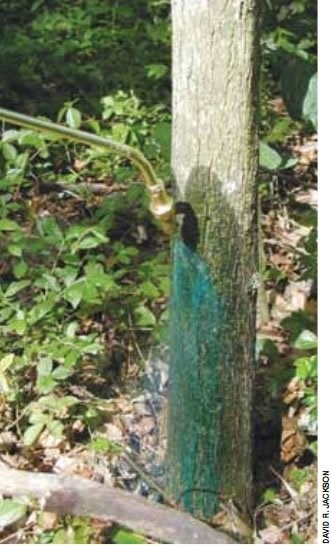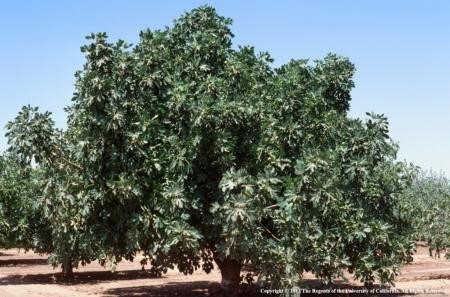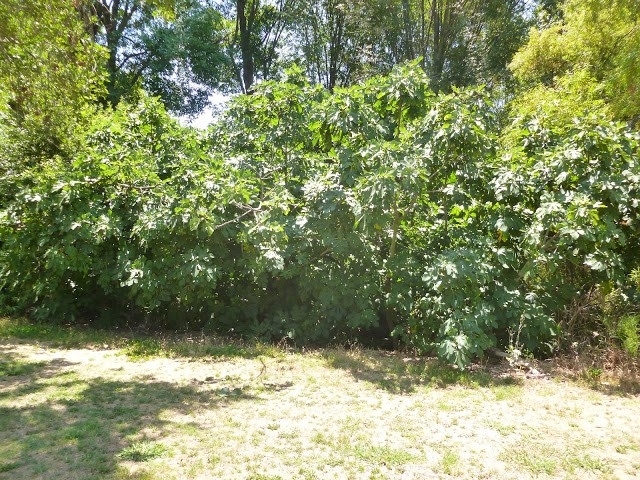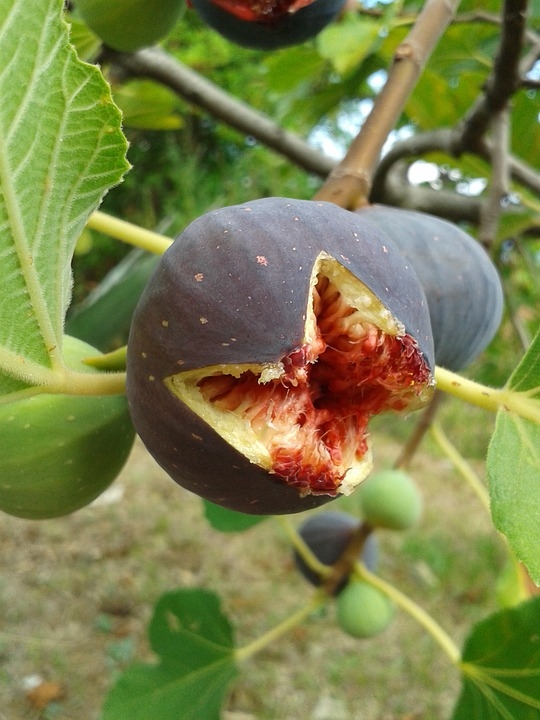This is the adventure of a livestock advisor trying to find a way to kill a fig tree. Normally we are doing our best to make fruit trees grow. In this case, Rebecca Ozeran had to find the best way to kill figs that were fouling the range. Her solution is not applicable to fruit tree growers in California. Triclopyr is not registered for edible fruit tree crops in CA. So, don't try this at home. There are other ways of doing it.
Mention of any pesticide in this message is not a recommendation.
Why a Livestock Advisor learned about fig trees
by Rebecca Ozeran
Livestock and Natural Resources Advisor
UCCE Fresno County
As a livestock and natural resources advisor, I don't expect to get questions about fruit trees such as figs. As it turns out, I recently needed to know just enough about figs to provide information on how to kill them - a west Fresno County landowner contacted me to ask how he could get rid of some fig trees that were threatening his belowground water pipelines.
Before writing this post, I did my due diligence and confirmed that no one has already discussed fig trees as the target of weed control on this blog. The only mentions of fig trees in the UC Weed Science blog history are a listing of approved herbicides to control weeds in California subtropical crops as of 2 years ago1 and a mention that fig was one of several crops undergoing residue trials last summer2. Triclopyr is, interestingly, not on the list of approved herbicides. (This will be important later.)
Now that we've established this, we have to ask: Why and how are we getting figs on rangelands in Fresno County? And why does it matter?
Figure 1. Mature fig trees in an orchard.
For starters, Fresno County used to have several thousand acres of cultivated figs (nearly 13,000 ac in 19663, but less than 7,500 ac as of 20164), so there are many places in the county where volunteer figs can be seen sprouting, including in newer subdivisions where fig orchards used to be, e.g. the "Fig Garden" region of the city of Fresno. Landowners also may have decided to plant figs on their rural properties as a source of fresh fruit and/or shade, and once established, the figs were able to reproduce and spread. Although fig populations seem to grow slowly in new areas, figs have invaded riparian and other natural areas throughout California's Central Valley5 and can be tough to control once established.
Of course, if fig didn't cause any problems where it grew in these natural areas, we wouldn't be talking about it today. Unfortunately, fig is capable of displacing native plants and forming thick clusters of fig where nothing else can grow5, often in riparian areas. This is problematic for livestock owners, since grazing animals don't find fully grown fig trees appetizing. This can also be bad news for the biodiversity found in riparian areas, as figs become a monoculture. In addition, fig tree clusters decrease ground cover from litter (fallen leaves, grass stems, etc.) which means the fig-dominated areas have more bare soil than grassy or shrubby areas.
Figure 2. Weedy figs create dense stands that exclude other vegetation.
Trees also tend to evapotranspire more water than herbaceous plants like grasses, so they can actually take more water from stream systems and lower stream water levels6. The combination of lower water levels and higher potential for soil erosion can then cause trouble for water quality, and especially for aquatic animals who may require certain water temperatures, clarity, or depth to survive. Lastly, there is the threat fig roots pose to water infrastructure (pipelines) as seen by the landowner who contacted me in the first place.
Hopefully at least one of those consequences helped to illustrate why someone might consider fig a weed. Fortunately for me, several Weed Workgroup members provided great information when I reached out for advice. Mechanical treatments are impractical, as fig can create new sprouts from cut stumps, stems, and roots, and repeated treatments are not always feasible. Applying glyphosate alone to the leaves is ineffective; more effective are cut stump or basal bark applications of various herbicides, including combinations listed in the informative Weed Control in Natural Areas7. Based on the book, very little is known about the efficacy of many herbicide treatments on fig itself, and treatment recommendations are based on their use in other species. Only triclopyr (told you it would be important) has been tested explicitly on fig. Triclopyr is particularly effective when applied as a basal bark treatment. A great resource explaining basal bark treatment can be found below8.

Figure 3. Tree receiving basal bark herbicide treatment.
A non-UC member of the workgroup, Dr. Kerri Steenworth of USDA-ARS, referred me to Dr. Katherine Holmes, a restoration ecologist who is currently Assistant Executive Director of Solano County RCD and Chair of Solano County Weed Management Area. Dr. Holmes has investigated riparian and rangeland restoration connected to fig tree invasion in California's Central Valley5,9,10. When I spoke with Dr. Holmes, she confirmed that triclopyr basal bark treatments have been the most effective in her experience. She has never attempted stem injection or cut stump application on figs but hypothesizes that the strong sap flow would likely reduce the effectiveness of injected herbicide, and that the root system of cut and treated stumps may still be able to create new stems. Dr. Holmes suggested coating the basal 6 to 8 inches of the fig trunk with a mixture of 75% Hasten (surfactant) and 25% Garlon 4 (triclopyr), as long as the tree wasn't in or near water. Basal bark treatments require that the tree is still alive for enough time for the herbicide to be distributed through the vascular system.
In sum, fig trees are a weed issue I never imagined, but fortunately there seems to be an effective solution. More research on treating this species as a weed could be valuable, as fig production is in decline in Fresno County and fig invasion may continue in natural areas. For now, we at least have one blog post about controlling weedy fig trees.
References:
- Weed Control in Subtropical Tree Crops. //ucanr.edu/blogs/ucdweedscience/blogfiles/32828.pdf
- Treevix Labeled for Use in California Pomegranates. //ucanr.edu/blogs/blogcore/postdetail.cfm?postnum=21326
- 1966 Fresno County Crop Report. Available at http://www.co.fresno.ca.us/departments/agricultural-commissioner/crop-report-history.
- 2016 Fresno County Crop Report. Available at http://www.co.fresno.ca.us/departments/agricultural-commissioner/crop-report-history.
- Holmes, K. 2008. Invasive fig trees (Ficus carica) in the riparian forests of California's Central Valley: population growth, community impacts, and eradication efforts [dissertation]. Available at https://search.proquest.com/docview/304698102/previewPDF/7D691548E68B4426PQ/1?accountid=14515
- Hibbert, A. R. 1983. Water yield improvement potential by vegetation management on western rangelands. Water Resourves Bulletin 19: 375-381.
- DiTomaso, J.M., G. B. Kyser, S. R. Oneto, R. G. Wilson, S. B. Orloff, L. W. Anderson, S. D. Wright, J. A. Roncoroni, T. L. Miller, T. S. Prather, and C. Ransom. 2013. Weed Control in Natural Areas in the Western United States.
- Enloe, S., N. Loewenstein, W. Kelley, and A. Brodbeck. 2010. Basal bark herbicide treatment for invasive plants in pastures, natural areas, and forests. Alabama Cooperative Extension System, Agronomy and Soils Series. http://www.aces.edu/timelyinfo/Ag%20Soil/2010/December/Dec_2010.pdf
- Holmes, K. A. and A. M. Berry. 2009. Evaluation of off-target effects due to basal bark treatment for control of invasive fig trees (Ficus carica). Invasive Plant Science and Management 2:345-351.
- Holmes, K. A., S. E. Greco, and A. M. Berry. 2014. Pattern and process of fig (Ficus carica) invasion in a California riparian forest. Invasive Plant Science and Management 7:46-58.
Figures:
- Retrieved from https://ucanr.edu/repository/fileimage.cfm?article=99170&p=HVFBYB
- Retrieved from http://figs4funforum.websitetoolbox.com/post/took-some-pictures-of-the-fig-forest-5952568.
- (C) David R. Jackson and Penn State Extension. Retrieved from https://extension.psu.edu/using-basal-bark-herbicide-applications-to-control-understory-tree-species.
Attached Images:


